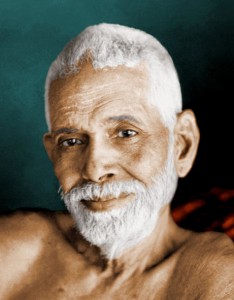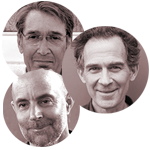 In advaita, Ramana Maharshi urged “‘tracing the ego back to the source” but what, exactly does this mean?
In advaita, Ramana Maharshi urged “‘tracing the ego back to the source” but what, exactly does this mean?
Here’s a question from a seeker:
“I am stuck at a point where I feel I need help … While reading Sri Ramana Maharshi’s work and talks, there is this constant mention of tracing the ego back to the source. When I try to do it there is an arresting of thoughts and a feeling near my chest and I am not able to proceed further. I will be very grateful if you could suggest something in this regard.”
The question begs for clarity of Ramana’s actual meaning when he referred to “tracing the ego back to the source” and the “heart” located in the chest region.
Who better to discuss this matter than Michael James, who tirelessly translated Shri Ramana’s work from Tamil and worked closely with his former students, Sri Muruganar and Shri Sadhu Om?
Michael James’ work is unique in that it’s clarity and authenticity are impeccable. James came to believe that many of the people who translated Sri Ramana Maharshi’s teachings into English did not have a clear understanding of the practice he taught. In fact, Michael classified some of the more popular texts as “confusing and misleading,” particularly in their discussions of Atma Vichara, the method of self Inquiry, which he felt had been mercilessly reduced to the over simplified mantra, “Who am I?”
To his great credit, Michael James translated from Tamil and published many works by Ramana (including what many consider his most important work, “Nan Yar?”, meaning, ‘Who am I?’ available as a PDF on our site … this is also available at Michael’s website – where he provides detailed translation of the paragraphs) and English translations of books of some of his students, including the remarkable Sri Sadhu Om, who studied with Ramana for more than five years and later with Sri Muruganar.
Here is exactly how Michael James answered this vital question:
What exactly does ‘tracing the ego back to the source’ mean? To answer this question we must first understand how the ego left its source, because as Sri Ramana sometimes used to say, we must ‘go back the way we came’, and before we can do that, we must understand what ‘the way we came’ actually is.
In verse 25 of Ulladu Narpadu, Sri Ramana explains how the ego rises from its source (our real self), how it remains away from its source, and how it will eventually subside back into its source:
Grasping form [that is, attaching itself to a body] it comes into existence; grasping form [that is, attending to thoughts or perceptions of a seemingly external world] it stands [or endures]; grasping form it feeds and grows [flourishes or expands]; leaving [one] form it grasps [another] form. If [we] seek [search, investigate, examine or scrutinise it], it will take flight. Know [that this is the nature of this] formless ghost-ego.
That is, since this ego has no form (no finite or separate existence) of its own, it can seemingly come into existence and endure only when we imagine ourself to be a form (a physical body), and it flourishes when we attend to any form (anything that appears to be separate from ourself). In other words, since this ego is thus just a ‘formless ghost’, it can rise, endure and flourish only by ‘grasping form’, and hence when it tries to ‘grasp’ (or attend to) itself, which is not a form, it will subside and disappear.
The truth that Sri Ramana teaches us here can therefore be rephrased thus: our mind or ego is nourished and sustained by attending to anything other than itself, and hence it will be dissolved and destroyed only by attending to itself. This is a fundamental and extremely important truth, which I have described elsewhere as the ‘first law of consciousness’ or ‘first law of the science of self-knowledge’.
In order to trace our ego back to its source, therefore, all that we need do is to scrutinize it keenly and closely, because as soon as we begin to attend to it, it will begin to subside and sink back into the source from which it originated. Thus we can ‘go back the way we came’ only by being vigilantly self-attentive.
You say that when you try to trace your ego back to its source, ‘there is an arresting of thoughts and a feeling near my chest and I am not able to proceed further’. When we attend to our ego, all other thoughts will naturally be arrested, because thoughts can rise and persist only when we think them, so when our mind is fully engaged in attending to itself (its essential thought ‘I’), no other thought can arise.
However, if we experience a feeling near our chest, our attention has obviously been distracted away from ourself towards our body. Since our body, our chest and any physical sensation are all only thoughts, we will not be aware of them when all thoughts have really been arrested.
That is, any feeling near our chest is only an objective experience — something that the knowing subject, ‘I’, experiences as other than itself — and all objective experiences are only thoughts that we form in our mind by our kalpanā-śaktior ‘power of imagination’ (which is otherwise called māyā), so as long as we experience any such objective phenomenon, we are not actually experiencing a state devoid of all thoughts. In the truly thought-free state, we will be conscious of nothing other than our mere being, ‘I am’.
Therefore, in order to ‘proceed further’, whenever we become aware of our body or of any feeling in it — or of anything else other than ‘I’ — we should regain our self-attentiveness by investigating ‘who am I, who am aware of these things?’
The fact that we can free ourself from all thoughts and return to the source (or ‘birthplace’) from which we arose as this ego only by attending vigilantly to ‘I’ is clearly explained by Sri Ramana in the sixth, tenth, thirteenth paragraphs of Nan Yar? (Who am I?:
… If other thoughts rise, without trying to complete them [we] should investigate to whom they have occurred. However many thoughts rise, what [does it matter]? As soon as each thought appears, if [we] vigilantly investigate to whom it has occurred, ‘to me’ will be clear [that is, we will be clearly reminded of ourself, to whom each thought occurs]. If [we thus] investigate ‘who am I?’ [that is, if we turn our attention back towards ourself in order to discover who or what we really are], [our] mind will return to its birthplace [our real self, which is the source from which it arose]; [and since we thereby refrain from attending to it] the thought which had risen will also subside. …
… As and when thoughts arise, then and there [we] should annihilate them all by vichāraṇā [vigilant self-investigation] in the very place [or source] from which they arise. …
… Without giving room even to the doubting thought, ‘Is it possible to dissolve so many vāsanās [desires to think and experience objective phenomena] and be only as self?’, [we] should cling tenaciously to svarūpa-dhyāna [self-attentiveness]. …
Being completely absorbed in ātma-niṣṭha [self-abidance], not giving even the slightest room to the rising of any other chintanā [thought] except ātma-chintanā [self-contemplation or self-attentiveness], alone is giving ourself to God. …
Therefore in practice ‘tracing the ego back to its source’ means only attending vigilantly to our ego or finite sense of ‘I’ in order to make it subside back into our pristine non-dual self-conscious being, ‘I am’, which is the source or ‘birthplace’ from which it originated.
To read more by Michael James, be sure to visit his magnificent blogspot, The Happiness of Being, and await his updates. Michael’s blog is “A collection of articles discussing the philosophy and practice of the spiritual teachings of Bhagavan Sri Ramana …” and is “… an extension of his main website: Happiness of Being.”







Thankyou, James. You are clear
and, precise, in your explanations of, Sri Ramana’s
teaching. Perhaps, some: who
read the explanations, miss the
truth, by way, of, wanting to
have their cake and, eat it, too ? Which , is, exactly, what
Ramana, explained in his
teaching: for, those who are
ready to recieve it. To recieve
what it says about who they
are, and, are not. Of, course,
the essence of, the teaching,
is more than a concept: even though, we speak
of, it, in a seeming world of,
adjuncts and, root of, adjuncts.
Thankyou, Sri Ramana. Thankyou, Sri Sadhu Om.
Thankyou, Michael James.
Sincerely,
Tom
P.S– Michael, thankyou, so
much, for, what you have
helped to, clarify. Your
help, is, invaluable.
Tom,
Thanks for taking the time to comment.
Glad that Michael’s answer was helpful and valuable.
Sanjiv
Thank you for sharing the link to the Who Am I? (Nan Yar) PDF. The one I have in question and answer format, consisting of 28 questions. I have heard of the version you shared but not found it till now. I look forward to reading it. I have read the version I found a few months ago 8 times already.
Paul,
My apologies for this delayed reply.
Glad we could provide the version you were looking for 🙂 …. indeed Nan Yar is most illuminating!
Thanks for stopping by.
Sanjiv
and this “I am” precedes merging with the Absolute (Samadhi)…..
Indeed Hans 🙂
Seeing your comment I remembered I am seriously delinquent in a pending email reply to you (my apologies) …. will do my best to get to it this week .. but likely next week.
Hope all is well with you.
Happy Holidays!
Sanjiv
Everything appears separate, the illusion of separation, yet everything is one.
Why would the eternal source wish to realize itself in the ephemeral ?